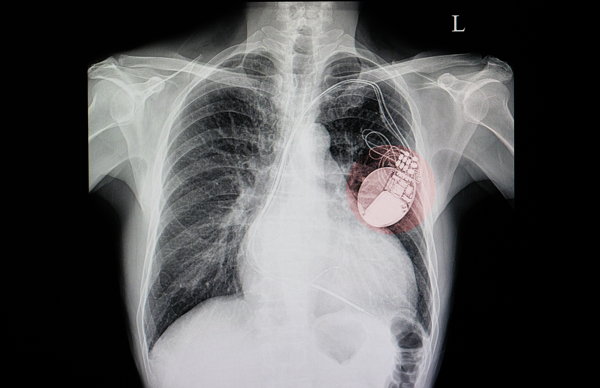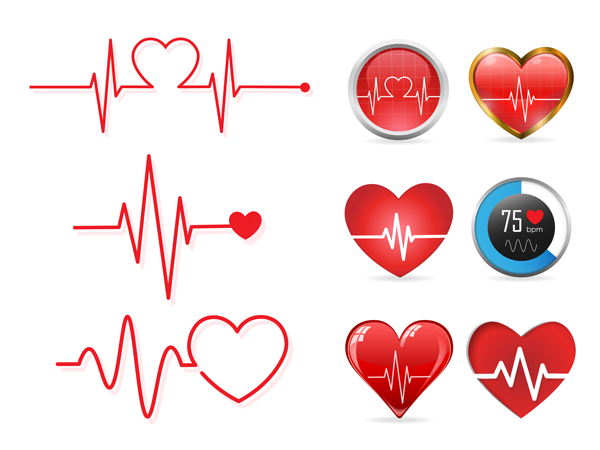
NORMAL HEARTBEAT & ARRHYTHMIA
A human heart has four chambers. The upper two are called the Atria (subdivided as Left & Right) and the lower two are called Ventricles (subdivided as Left & Right). A heart has its own electrical pulse system, with the help of which, it works and pumps blood to the body via contraction & relaxation mechanism. With every pulse, heart contracts & pumps blood. The primary purpose of a pacemaker implantation is to maintain an adequate heart rate. A chest X-ray will be done after the pacemaker implantation to check your lungs as well as the position of the pacemaker and lead(s). The pacemaker implantation procedure takes place in a special room in the Pacemaker Lab. When the epicardial pacemaker implant approach is used, the procedure takes place in a surgical suite.
Initially, the group of cells where the pulse begins is called a sinus node or Sinoatrial (SA) node. This node is situated in the right atrium. When the SA node generates a signal, blood flows from the atria to the ventricles. Thus, one combined contraction between the atria and the ventricles is called as a Heartbeat.
As heartbeats are rhythmic, an adult human being at rest has 60-100 beats per min. In a condition called Arrhythmia, a heart beats either too fast, or too slow. A heartbeat that is too long is called Tachycardia. The heartbeat which is too slow is called Bradycardia.
Not all arrhythmia are abnormal. While exercising, it may go beyond 100. While relaxing/sleeping, it may come down below 60 as well which is perfectly normal.
SIGNS & SYMPTOMS
An arrhythmia may be present and not show any symptoms. A doctor can detect an irregular heartbeat during a regular checkup by taking your pulse, listening to your heart via stethoscope or by performing diagnostic tests. If symptoms occur, they are as follows:
- Palpitation, a feeling of skipped heartbeats, fluttering feeling that the heart is “running away”
- Pounding in the chest
- Dizziness or feeling lightheaded
- Shortness of breath
- Weakness or fatigue
REASONS
Arrhythmias can be caused by:
- Coronary artery disease
- High blood pressure
- Changes in the heart muscle
- Valve disorders
- Electrolyte imbalances in the blood, such as sodium or potassium
- Injury from a heart attack
- The healing process after heart surgery
- Other medical conditions

THE NEED OF A PACEMAKER IMPLANTATION
When a heart has difficulty in producing pulses causing arrhythmia, then the body might need an artificial device to generate that signal. Such a device is fitted in the chest area. This artificial device that prompts the heart to regularize its beating pattern is called as a Pacemaker. It is an electrical device and consists of two parts. One part is called a Pulse generator. This contains a battery and electronics that control your heartbeats. The other part is one or more leads to send electrical signals to your heart. Leads are small wires that run from the pulse generator to your heart.
A pacemaker regulates your body’s electrical system, thus controlling your heartbeat rhythm. With each heartbeat, an electrical impulse travels from the top of your heart (atria) to the bottom (Ventricles), signaling your heart’s muscles to contract pump blood.
A pacemaker can also track and record your heartbeat. This record helps your doctor better understand your arrhythmia.
THE TYPES OF PACEMAKER IMPLANTATION
SINGLE CHAMBER:
In a single chamber pacemaker, there is only one lead is used. This single lead is used to achieve proper contractions in the right atrium.
DUAL CHAMBER:
In a dual-chamber pacemaker, two leads are used. One is attached to the right atrium and the other one to the right ventricle in order to regulate proper blood pumping in the right side of the heart.
BIVENTRICULAR:
This implantation is also called as Cardiac Resynchronization Therapy. Here, three leads are used out of which one is attached to the right atrium and the other two are attached to the two ventricles; one lead per ventricle. Biventricular pacemakers are used in advanced heart failures when the lower chambers of the heart lose their coordination.
THE PACEMAKER SURGERY
You will be given sedatives to relax your body. You are likely to be awake throughout the procedure which takes around 2 hours.
Firstly, there will be an incision on your shoulder. Through that, one or more wires will be guided into a major vein under your collarbone. These wires will be guided to the desired part of your heart using a fluoroscopic X-ray machine.
Once the wires reach the desired part, that is, atria or ventricles, one end of them is placed onto them and the other one is attached to the battery beneath the skin of your chest. This battery works as a generator. Thus, pacemaker surgery is conducted.
You will be admitted to the hospital for a day or two. Your pacemaker will be adjusted as per the requirement. After this procedure, you will be advised to take care of certain factors.
Cellphones: Although cellphones are allowed, don’t keep them in your shirt’s pocket. Keep it away at least 6 inches from the chest. While talking, hold it to the ear on the opposite side of your chest where the pacemaker is implanted.
Metal detectors: your pacemaker won’t interfere with a metal detector, but you will need to carry a card that says you have a pacemaker implanted. Avoid lingering around a metal detector.
There is no such risk involved in the pacemaker implantation surgery. But avoid getting involved in heavy workouts for a month after implantation. Your battery has a life for five to fifteen years. The battery can be replaced if it is drained out and this procedure is quicker and easier than the implantation procedure. Your symptoms of fainting, dizziness, breath shortness should go away with the pacemaker implantation.

